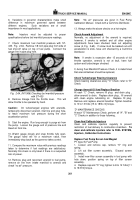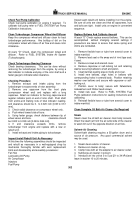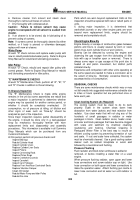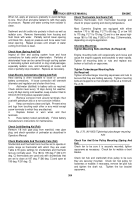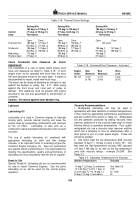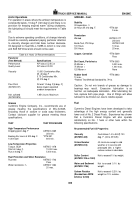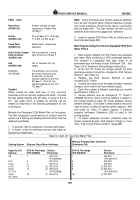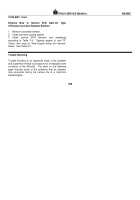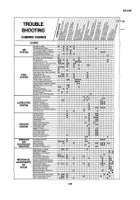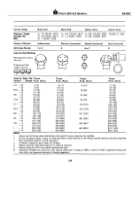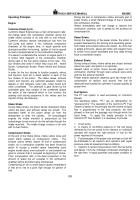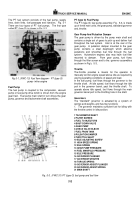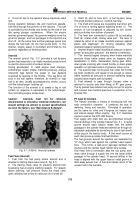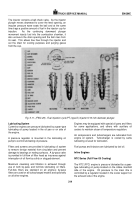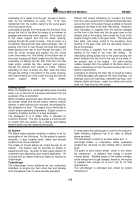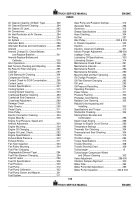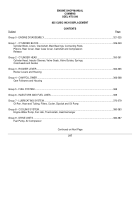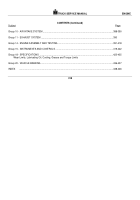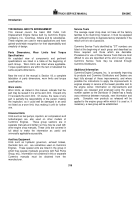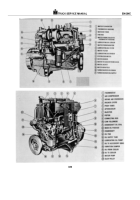TM-5-3805-254-14-P-2 - Page 315 of 894
TRUCK SERVICE MANUAL
ENGINE
Operating Principles
Engine
Cummins Diesel Cycle
Cummins Diesel Engines have a high compression ratio;
the charge taken into combustion chamber during the
intake stroke consists of air only with no fuel mixture.
Cummins injectors receive low-pressure fuel from the
fuel pump and deliver it into individual combustion
chambers at the proper time, in equal quantity and
atomized condition for burning.
Ignition of fuel is caused
by heat of compressed air in the combustion chamber.
It is easier to understand the function of engine parts if it
is known what happens in the combustion chamber
during each of the four piston strokes of the cycle.
The
four strokes and order in which they occur are:
Intake
Stroke, Compressor Stroke, Power Stroke and Exhaust
Stroke.
In order for the four strokes to function properly, valves
and injectors must act in direct relation to each of the
four strokes of the piston.
The intake valves, exhaust
valves and injectors are camshaft actuated, linked by
tappets or cam followers, push rods, rocker levers and
valve crossheads.
The camshaft is gear driven by the
crankshaft gear, thus rotation of the crankshaft directs
the action of the camshaft which in turn controls the
opening and closing sequence of the valves and the
injection timing (fuel delivery).
Intake Stroke
During intake stroke, the piston travels downward; intake
valves are open, and exhaust valves are closed.
The
downward travel’ of the piston allows air from the
atmosphere to enter the cylinder.
On turbocharged
engines the intake manifold is pressurized as the
turbocharger forces more air into the cylinder through the
intake manifold.
The intake charge consists of air only
with no fuel mixture.
Compression Stroke
At the end of the intake stroke, intake valves close and
piston starts upward on compression stroke.
The
exhaust valves remain closed. At end of compression
stroke, air in combustion chamber has been forced by
piston to occupy a smaller space (depending upon
engine model about one-fourteenth to one-sixteenth as
great in volume) than it occupied at beginning of stroke.
Thus, compression ratio is the direct proportion in the
amount of space the air occupies in the combustion
chamber before and after being compressed.
Compressing air into a small space causes temperature
of that air to rise to a point high enough for ignition of
fuel.
During last part of compression stroke and early part of
power stroke, a small metered charge of fuel is injected
into combustion chamber.
Almost immediately after fuel charge is injected into
combustion chamber, fuel is ignited by the existing hot
compressed air.
Power Stroke
During the beginning of the power stroke, the piston is
pushed downward by the burning and expanding gases;
both intake and exhaust valves are closed.
As more fuel
is added and burns, gases get hotter and expand more
to further force piston downward and thus adds driving
force to crankshaft rotation.
Exhaust Stroke
During exhaust stroke, intake valves are closed, exhaust
valves are open, and piston is on upstroke.
Upward travel of piston forces burned gases out of
combustion chamber through open exhaust valve ports
and into the exhaust manifold.
Proper engine operation depends upon two things first,
compression for ignition; and second, that fuel be
measured and injected into cylinders in proper quantity at
proper time.
Fuel System
The PT fuel system is used exclusively on Cummins
Diesels.
The identifying letters, "PT," are an abbreviation for
"pressure-time." The operation of the Cummins PT Fuel
System is based on the principle that the volume of liquid
flow is proportionate to the fluid pressure, the time
allowed to flow and the passage size through which the
liquid flows.
To apply this simple principle to the
Cummins PT Fuel System, it is necessary to provide:
1.
A fuel pump.
2.
A means of controlling pressure of the fuel being
delivered by the fuel pump to the injectors so individual
cylinders will receive the right amount of fuel for the
power required of the engine.
3.
Fuel passages of the proper size and type so fuel will
be distributed to all injectors and cylinders with equal
pressure under all speed and load conditions.
4.
Injectors to receive low-pressure from the fuel pump
and deliver it into the individual combustion chambers at
the right time, in equal quantities and proper condition to
burn.
311
Back to Top

